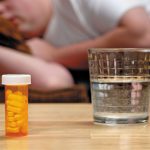What to Avoid When Taking Low Dose Naltrexone

For most people, taking a new medication may mean switching up your lifestyle a bit and that includes the foods you eat. A drug interaction is a reaction between two (or more) drugs or between a drug and a food, beverage, or supplement. Taking a drug while having certain medical conditions can also cause a drug interaction.
A food-drug interaction means that a specific nutrient or compound within the food changes the way your body metabolizes the medication, and this can either enhance or reduce the dose your body gets, according to Johns Hopkins Medicine. The potential results: an increased risk of side effects, many of which can be dangerous, or the drug not working as it was intended.
Before introducing a medication, ask your pharmacist about any food interactions, including with alcohol, and any adjustments you may have to make to your diet. In this article, we will discuss Naltrexone and the foods to avoid while taking it.
What Is Naltrexone?
Naltrexone is in a class of medications called opiate antagonists. It works by decreasing the craving for alcohol and blocking the effects of opiate medications and opioid street drugs. Intramuscular extended-release Naltrexone is approved by the Food and Drug Administration (FDA) to treat both Opioid Use Disorder (OUD) and Alcohol Use Disorder (AUD) as a Medication-Assisted Treatment (MAT) option.
Low-dose naltrexone (LDN) has been demonstrated to reduce symptom severity in conditions such as fibromyalgia, Crohn’s disease, multiple sclerosis, and complex regional pain syndrome.
Though physicians previously prescribed Naltrexone to treat opioid addictions, they now are employing the drug in off-label uses to aid patients with conditions ranging from pain and a dysfunctional immune system, to inflammation, cancer, and mental health issues.
How Naltrexone Works
Naltrexone is not an opioid, is not addictive, and does not cause withdrawal symptoms with the stop of use. Naltrexone blocks the euphoric and sedative effects of opioids such as heroin, morphine, and codeine. Naltrexone binds and blocks opioid receptors, and reduces and suppresses opioid cravings. There is no abuse and diversion potential with naltrexone.
Naltrexone works by temporarily binding and blocking a mechanism called the MU receptor, which is linked to pain. Blocking the receptor tells our bodies that we aren’t producing enough endorphins (our natural pain relievers), and then releases them.
Peak naltrexone plasma concentrations are reached within 1 hour of dosing. The long-acting properties of naltrexone are due primarily to 6-β-naltrexol, which has an elimination half-life of 13 hours. Naltrexone achieves therapeutic effectiveness rapidly following the initiation of oral dosing.
How should Low-dose naltrexone (LDN) be used?
Naltrexone comes as a tablet to take by mouth either at home or under supervision in a clinic or treatment center. When naltrexone is taken at home, it is usually taken once a day with or without food.
Studies have discovered that, giving patients doses far less than the 50 mg dose was able to achieve pain relief. Doctors usually start patients with a 1.5 mg dose on an empty stomach at night, and then look for a response after a few weeks.”
Most patients using the medication off-label report pain relief greater than 50 percent and sleep sleeping better. Some patients end up responding well to doses as low as 0.1 for reasons scientists don’t yet completely understand.
Follow the directions on your prescription label carefully, and ask your doctor or pharmacist to explain any part you do not understand. Take naltrexone exactly as directed. Do not take more or less of it or take it more often than prescribed by your doctor.
What should I avoid when taking low-dose naltrexone (LDN)?
There are several foods and beverages that should be avoided while taking low-dose naltrexone (LDN) because they can affect the way the medication works. They include:
Diabetes medication: If you are taking any medication including herbs and supplements for diabetes, inform your doctor. Naltrexone may increase the risk of hypoglycemia (low blood sugar) in patients with diabetes. Low blood sugar must be treated before it causes you to pass out (unconsciousness). People feel different symptoms of low blood sugar.
St. John Wort: Avoid taking St. John’s wort while taking low-dose naltrexone (LDN), because both have an effect on serotonin levels in the blood. Too much serotonin is a potentially life-threatening situation. Severe signs and symptoms include high blood pressure and increased heart rate that lead to shock.
Grapefruit juice: Avoid taking grapefruit juice while taking low-dose naltrexone (LDN) because it can result in additive CNS depression and impairment of judgment, thinking, and psychomotor skills. In more severe cases, hypotension, respiratory depression, profound sedation, coma, or even death may occur.
Alcohol: Avoid consuming alcohol while taking low-dose naltrexone (LDN) for pain. Drinking too much alcohol can trigger pain and tingling in the limbs. This is known as alcoholic neuropathy. In people with alcoholic neuropathy, the peripheral nerves have been damaged by too much alcohol use.
Potassium Supplements: The therapeutic efficacy of Potassium citrate can be decreased when used in combination with low-dose naltrexone (LDN).
Other products that may interact with this drug include dextromethorphan, diarrhea medication (such as diphenoxylate), disulfiram, opioid pain, or cough relievers (such as codeine, hydrocodone), and thioridazine.
It is always a good idea to maintain a healthy and balanced diet to support overall well-being. Here are some general dietary recommendations:
1. Balanced Nutrition: Consume a diet that includes a variety of nutrient-rich foods, such as fruits, vegetables, whole grains, lean proteins, and healthy fats. This can help support your overall health and provide essential vitamins, minerals, and antioxidants.
2. Hydration: Stay adequately hydrated by drinking plenty of water throughout the day. Limit sugary beverages and alcohol intake.
3. Avoid Food Allergies or Sensitivities: If you have known food allergies or sensitivities, it is important to continue avoiding those specific foods while taking LDN.
4. Individual Considerations: If you have specific dietary needs or health conditions, it is advisable to consult with a healthcare professional or a registered dietitian who can provide personalized recommendations based on your individual situation.
It’s important to note that LDN is a medication that should be taken as prescribed by your healthcare provider. If you have any concerns or questions about the use of LDN and your diet, it’s always best to consult with your healthcare provider for guidance and personalized advice.





